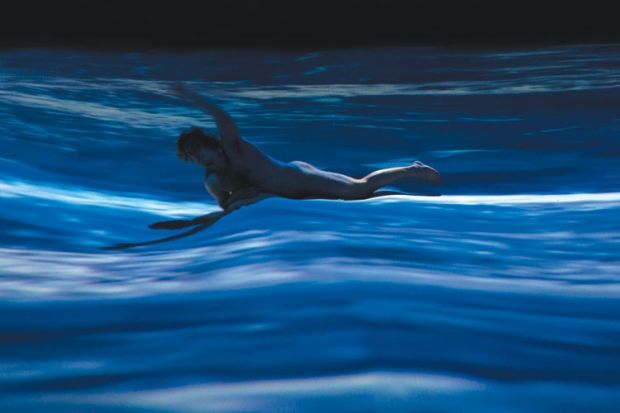Source: Angela Alegria
Leviathan: rage and ritual drowning
A Falmouth University academic is staging a new version of Moby-Dick that culminates in “a ritual of communal drowning”.
Klaus Kruse, coordinator of the acting course at Falmouth, is also a poet, performer, songwriter and director. In 2007, while studying for his MA at Dartington College of Arts (now incorporated into the university), he co-founded the Living Structures collective. He now serves as its artistic director.
Living Structures specialises in immersive theatre, using music, puppetry, video and sculpture in what they describe as “multi-media events in mind-baffling environments”. Their first show, Cart Macabre, which began to be developed in 2007, took groups of 32 people on “a nightmare fairground ride” through darkness, with unexpected objects emerging through peepholes, shutters and sliding doors. One critic described the experience as leaving him “both terrifyingly powerless and unexpectedly liberated”.
This was followed by Biosphere in 2009 and now by Leviathan. This was first performed at the Matadero in Madrid in 2012, where it was praised for its “relentless onslaught of manic inventiveness…Beautiful choral singing gives way to strange industrial rhythms, or discordant string notes, or screeching seagulls, or crazed chanting.” It continues at the Hackney Downs Studios in London until 26 July.
As Moby-Dick is a huge book, said Mr Kruse, “we had to be very selective. Basically, a crew of people go on a journey, following Captain Ahab and his rage, who leads them to their doom – and a ritual of communal drowning.” Only 120 people can attend each performance.
In some immersive theatre productions, audience members may wander where they like and so everybody emerges having seen a different show. Mr Kruse prefers spectators to remain where they are while the space is transformed around them, although descending sheets may segregate them into shifting groups and they can decide for themselves to what extent they want to interact with the performers.
Two weeks of development for Leviathan took place at Falmouth’s Academy of Music and Theatre Arts before the team moved to Hackney. Recent graduates and students on work placements are involved in the production alongside the creative core of four long-term collaborators and people brought in especially, including aerialists from France. Mr Kruse believes his creative work often feeds into his teaching, as in a module investigating spatial interaction between audiences and performers.
More important, however, he sees Living Structures as at the heart of his research.
“We are looking at sound,” he explains, “the directionality of sound and how it can be used to open up a space that audiences can enter and experience. We are interested in using space as an active ingredient in storytelling. Much is done in Leviathan through spatial transformation – which takes the audience to a new location or confronts them with a new set of ideas. But it also needs to be fun and engaging. That has to be part of research as well.”
Register to continue
Why register?
- Registration is free and only takes a moment
- Once registered, you can read 3 articles a month
- Sign up for our newsletter
Subscribe
Or subscribe for unlimited access to:
- Unlimited access to news, views, insights & reviews
- Digital editions
- Digital access to THE’s university and college rankings analysis
Already registered or a current subscriber? Login





